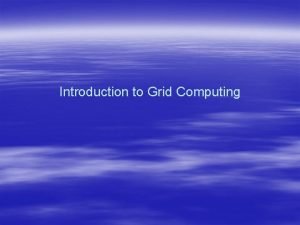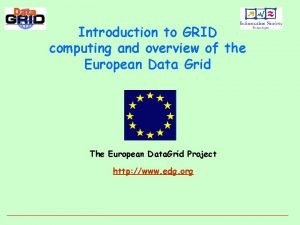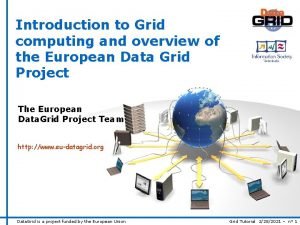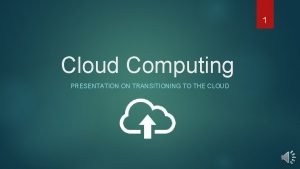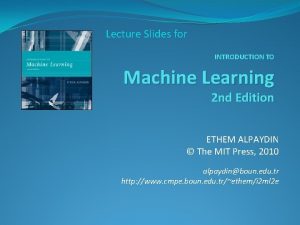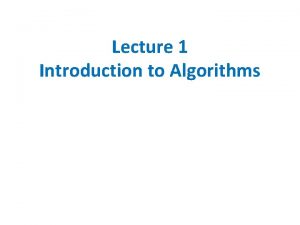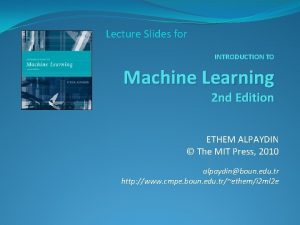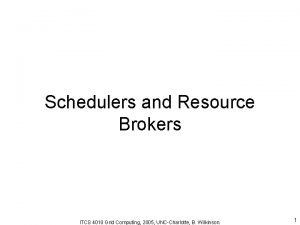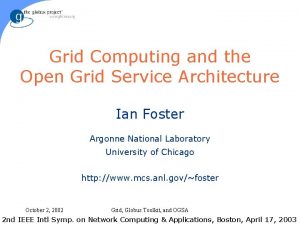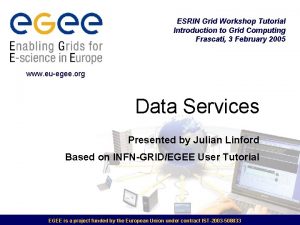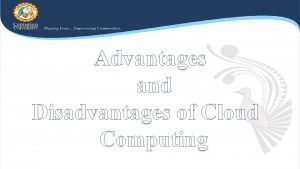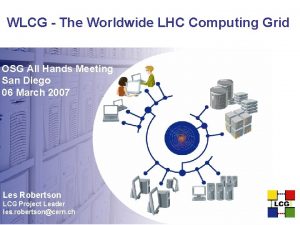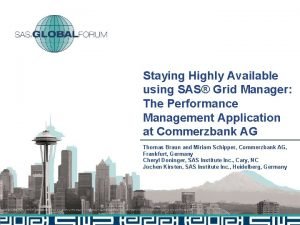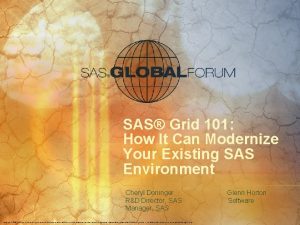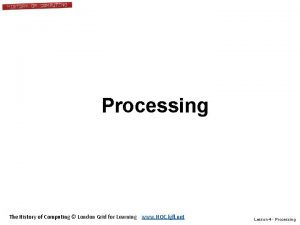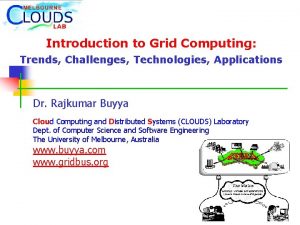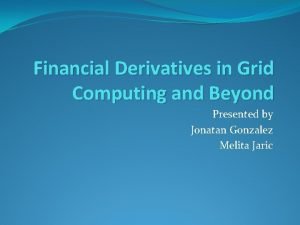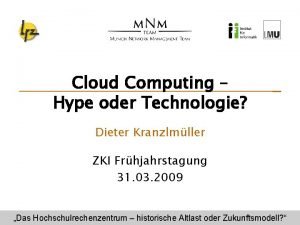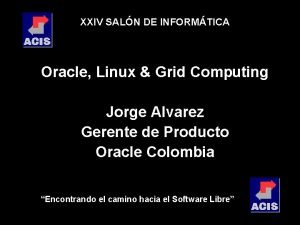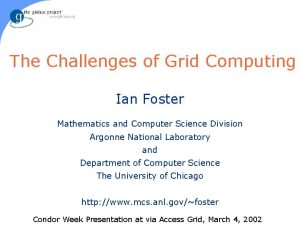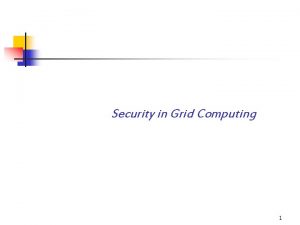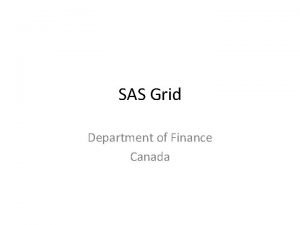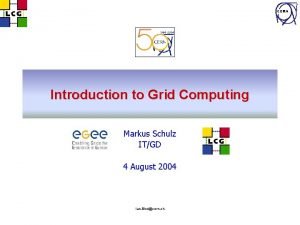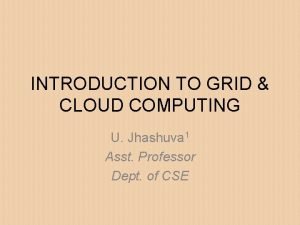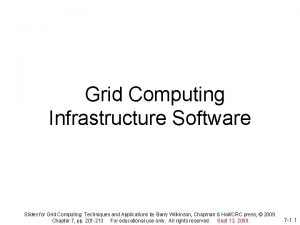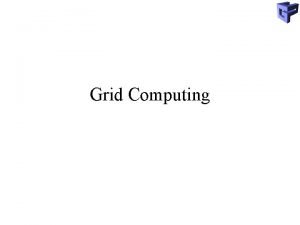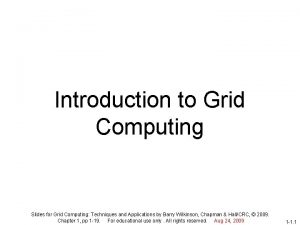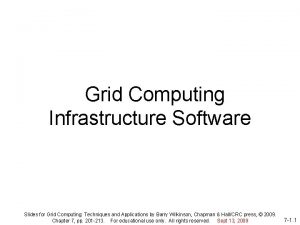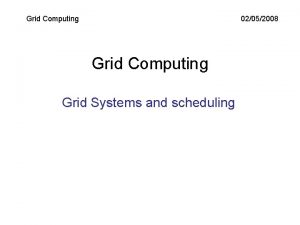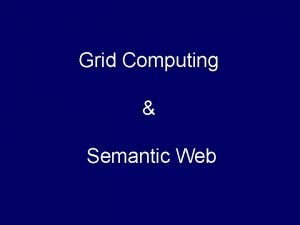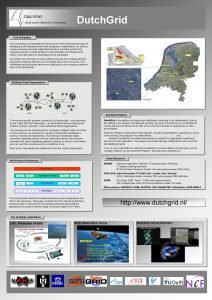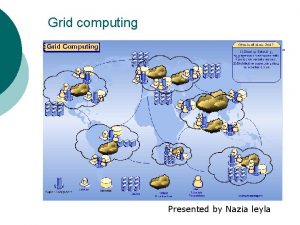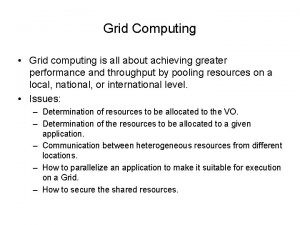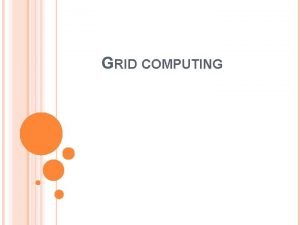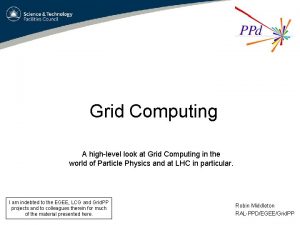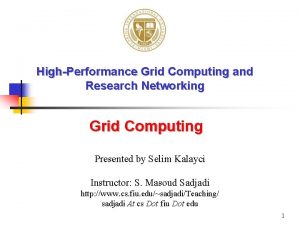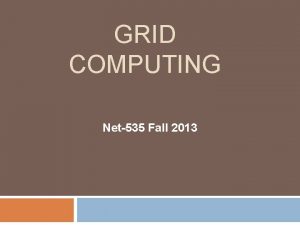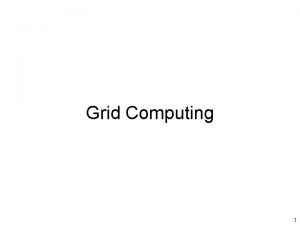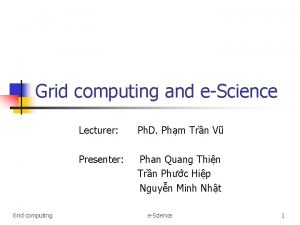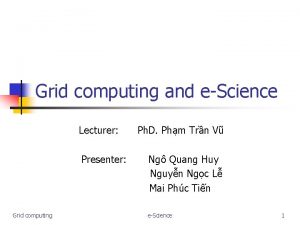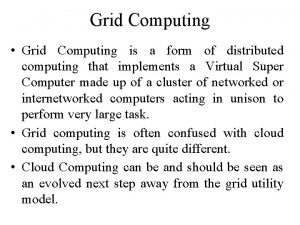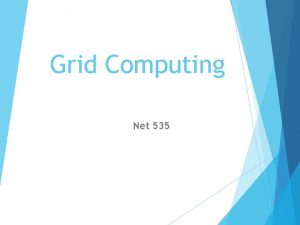Introduction to Grid Computing Slides for Grid Computing
















































































- Slides: 80

Introduction to Grid Computing Slides for Grid Computing: Techniques and Applications by Barry Wilkinson, Chapman & Hall/CRC, © 2009. Chapter 1, pp 1 -19. For educational use only. All rights reserved. Aug 24, 2009 1 -1. 1

Grid Computing • Using geographically distributed and interconnected computers together for computing and for resource sharing. “The grid virtualizes heterogeneous geographically disperse resources” from "Introduction to Grid Computing with Globus, " IBM Redbooks 1 -1. 2

“Grid” • Common practice to use word Grid as a proper noun (i. e. G is capitalized) although does not refer to one universe Grid. • There are many Grid infrastructures. • We have set up one for this course. • You will learn how that was done and the technicalities in the course. 1 -1. 3

Need to harness computers Original driving force behind Grid computing same as behind the early development of networks that became the Internet: – Connecting computers at distributed sites for high performance computing. 1 -1. 4

However, Grid computing is about collaborating and resource sharing as much as it is about high performance computing. 1 -1. 5

Virtual Organizations Grid computing offers potential of virtual organizations: – groups of people, both geographically and organizationally distributed, working together on a problem, sharing computers AND other resources such as databases and experimental equipment. 1 -1. 6

Different organizations can supply resources and personnel. Concept has many benefits, including: • Problems that could not be solved previously for humanity because of limited computing resources can now be tackled. Examples • • Understanding the human genome Searching for new drugs …. Continued. 1 -1. 7

• Users can have access to far greater computing resources and expertise than available locally. • Inter-disciplinary teams can be formed across different institutions and organizations to tackle problems that require expertise of multiple disciplines. • Specialized localized experimental equipment can be accessed remotely and collectively. Continued. 1 -1. 8

• Large collective databases can be created to hold vast amounts of data. • Unused compute cycles can be harnessed at remote sites, achieving more efficient use of computers. • Business processes can be re-implemented using Grid technology for dramatic cost saving. 1 -1. 9

Crosses multiple administrative domains. • Another hallmark of larger Grid computing projects. • Resources being shared owned either by members of virtual organization or donated by others. • Introduces challenging technical and social-political challenges. • Requires true collaboration. 1 -1. 10

• Some key features we regard as indicative of Grid computing: – Shared multi-owner computing resources – Uses Grid computing software, with security and cross-management mechanisms in place – Tools to bring together geographically distributed computers owned by others. 1 -1. 11

Shared Resources Can share much more than just computers: • • • Storage Sensors for experiments at particular sites Application Software Databases Network capacity, … 1 -1. 12

Interconnections and Protocols Focus now on: • using standard Internet protocols and technology, i. e. HTTP, SOAP, web services, etc. , 1 -1. 13

History of distributed computing Certainly one can go back a long way to trace the history of distributed computing. Types of distributed computing existed in 1960 s. Many people interested in connecting computers together for high performance computing. From connecting processors/computers together locally that began in earnest in the 1960 s and 1970 s, distributed computing now extends to connecting computers that are geographically distant - Grid computing. 1 -1. 14

Distributed computing technologies that underpin Grid computing developed concurrently and rely upon each other. Three concurrent interrelated paths: • Networks • Computing platforms • Software techniques 1 -1. 15

Networks 1960 s - Development of packet switched networks. 1969 - ARPNET network became operational. 4 nodes, Univ. of California at Los Angeles, Stanford Research Institute, Univ. of California at Santa Barbara, and Univ. of Utah. Design speed of 50 Kbits/sec. 1974 - TCP (Transmission Control Protocol) 1978 - TCP/IP (Transmission Control Protocol/Internet Protocol). TCP a protocol for reliable communication IP for network routing. IP addresses identify hosts on the Internet Ports identify end points (processes) for communication purposes. Early 1970 s - Ethernet for interconnecting computers on local networks. Early 1980 s - Internet. Uses the TCP/IP protocol. 1990 s - Internet developed into World-Wide Web. Browser and HTML markup language introduced. 1 -1. 16

Computing Platforms 1960 onwards - Recognized that increased speed could potentially be obtained by having more than one processor inside a single computer system Parallel computer coined to describe such systems. 1970 s and 1980 s - many parallel computer projects especially with advent of low cost microprocessors. 1990 s - cluster computing, a group of computers inter connected through a network switch to form a computing platform Commodity computers (PCs) provided cost-effective solution. 1 -1. 17

Typical cluster computing configuration Fig. 1. 1 1 -1. 18

Programming clusters Message passing programming -- Messages between processes specified by programmer using messagepassing routines: Late 1980 s - early 1990 s - PVM (Parallel Virtual Machine) Late 1990 s - MPI (Message Passing Interface) Late 1980’s onwards – Condor To harness “unused” cycles of networked computers for high performance computing. A collection of computers could be given over to remote access automatically when not being used locally. Widely used as a job scheduler for clusters in addition to its original purpose of using laboratory computers collectively. We will consider Condor in the light of Grid computing. 1 -1. 19

Software Techniques Mid 1980 s - Remote procedure call (RPC) for invoking a procedure on a remote computer. Service registry - introduced with RPC to locate remote services. 1990 s - Object-oriented versions of RPC: CORBA (Common Request Broker Architecture) Java Method Invocation (RMI). 2000 - Web service Provide remote actions as RPC but invoked through standard protocols and Internet addressing. Use XML (e. Xtensible Markup Language), also introduced in 2000. Web services and XML adopted into Grid computing soon after their introduction 1 -1. 20

Grid Computing History • Began in mid 1990 s with experiments using computers at geographically dispersed sites. • Seminal experiment – “I-way” experiment at 1995 Supercomputing conference (SC’ 95), using 17 sites across US running: – 60+ applications. – Existing networks (10 networks). 1 -1. 21

Globus Project Led by Ian Foster, a co-developer of I-Way demonstration, and founder of the Grid computing concept. Globus -- middleware software Grid computing toolkit. Evolved through several implementation versions although basic structural components remained essentially same: • Security, • Data management • Execution management • Information services • Run time environment) We will describe Globus in detail later.

Other grid computing middleware software Although Globus widely adopted and basis of the course, there are other software infrastructure projects. 1993 - Legion project Software development started in 1996 Used object-based approach to Grid computing. First public release at Supercomputing 97 in Nov. 1997. Led to Avaki company/software, taken over by Sybase Inc. 1990 s - UNICORE (UNiform Interface to COmputing REsources) European grid computing project. Initially funded by German Ministry for Education and Research. Continued with other European funding. Basis of several European efforts in Grid computing and elsewhere. Many similarities to Globus. 1 -1. 23

Key concepts in the history of Grid computing Fig. 1. 2 1 -1. 24

Applications • Originally e-Science applications – Computational intensive • Traditional high performance computing addressing large problems • Not necessarily one big problem but a problem that has to be solved repeatedly with different parameters. – Data intensive • Computational but emphasis on large amounts of data to store and process – Experimental collaborative projects 1 -1. 25

• Now also e-Business applications – To improve business models and practices. – Sharing corporate computing resources and databases – On-demand Grid computing … indirectly led to cloud computing. 1 -1. 26

Grid Computing verse Cluster Computing • Important not to think of Grid computing simply as large cluster because potential and challenges different. • Courses on Grid computing and on cluster computing are quite different. 1 -1. 27

Cluster computing course • One learns about : – Message passing programming using tools such as MPI, and – Shared memory programming using threads and Open. MP, given that most computers in a cluster today now multi-core shared memory systems. – Parallel algorithms (lots) • Network security is not a big issue. – Usually an ssh connection to front node of cluster sufficient. – User logging onto a single compute resource. • Computers connected together locally under one administrative domain 1 -1. 28

Grid computing course • Learn about running jobs of remote machines, scheduling jobs and distributed workflow • Learn in detail underlying Grid infrastructure • How Internet technologies applied to Grid computing • Grid computing software and standards • Security is an issue. 1 -1. 29

Grid Computing verse Cluster Computing • Of course, there are things in common • Both courses hands-on with programming experiences. • Both use multiple computers • Both require job scheduler to place jobs. 1 -1. 30

Cloud computing • Lot of hype on Cloud computing at the moment. • Business model in which services provided on servers that can be accessed through Internet. • Lineage of cloud computing can be traced back to on-demand Grid computing in the early 2000 s. 1 -1. 31

Cloud computing using virtualized resources Fig. 1. 3 1 -1. 32

• Common thread between Grid computing and cloud computing is use of Internet to access resources. • Cloud computing driven by widespread access that Internet provides and Internet technologies. • However cloud computing quite distinct from original purpose of Grid computing. 1 -1. 33

Grid Computing verse Cloud Computing • Whereas Grid computing focuses on collaborative and distributed shared resources, Cloud computing concentrates upon placing services for users to pay to use. • Technology for cloud computing emphases: – use of software as a service (Saa. S) – virtualization (process of separating particular user’s software environment from underlying hardware). 1 -1. 34

Ian Fosters’ check list Ian Foster credited for development of Grid computing. Sometimes called father of Grid computing Proposed simple checklist of aspects that are common to most true Grids: • No centralized Control • Standard open protocols • Non-trivial quality of service (Qo. S) 1 -1. 35

Computational Grid Applications • • • Biomedical research Industrial research Engineering research Studies in Physics and Chemistry … 1 -1. 36

Sample Grid Computing Projects 1 -1. 37

• Enterprise Grids – Grid formed within an organization for collaboration – Still might cross administrative domains of departments and requires departments to share their resources – Example: campus Grids 1 -1. 38

Example University of Virginia Campus Grid 1 -1. 39 1 a. 39

• Partner Grids -- Grids between collaborative organizations • This makes most use of potential of Grid computing and collaboration 1 -1. 40

Environment/Earth NSF Network for Earthquake Engineering Simulation (NEES) Transform our ability to carry out research vital to reducing vulnerability to catastrophic earthquakes from I. Foster

SCOOP Project Southeastern Coastal Ocean Observing and Prediction Program http: //scoop. sura. org/ • Integrating data from regional observing systems for real time coastal forecasts in SE • Coastal modelers with computer scientists to couple models, provide data solutions, deploy ensembles of models on the Grid, assemble real time results with GIS technologies. From: "Urgent Computing for Hurricane Forecasts, “ Gabrielle Allen, Urgent Computing Workshop, Argonne National Laboratory, April 25 th to 26 th, 2007 http: //scoop. sura. org/documents/Urgent. Computing_April 2007. pdf 1 -1. 42

SCOOP Prototype Distributed Laboratory Funded by ONR & NOAA 2005/2006 SCOOP Implementation Team Bedford Institute of Oceanography • Gulf of Maine Ocean Observing System Louisiana State University Texas A&M University of Alabama, Huntsville University of Florida University of North Carolina Virginia Institute of Marine Science • External Resources • e. g. SURAgrid regional grid infrastructure, www. sura. org/suragrid Renaissance Computing Institute MCNC Southeastern Universities Research Association From: Dr. Philip Bogden "Designing a Collaborative Cyberinfrastructure for Event-Driven Coastal Modeling, " Philip Bogden, Supercomputing 2006, Nov 2006, Tampa, Fl.

DOE Earth System Grid Goal Address technical obstacles to sharing and analysis of high-volume data from advanced earth system models www. earthsystemgrid. org 1 -1. 44

Earth System Grid II http: //www. csm. ornl. gov/Highlights/esg. html 1. 45

Medicine /Biology http: //www. ediamond. ox. ac. uk/ Project period: 2002 -2005 1 a. 46

Project period: 2002 -2005… http: //www. openmolgrid. org/ 1 -1. 47

Physics CERN LCH Computing grid (LCG) Large Hadron Collider experimental facility for complex particle experiments at CERN (European Center for Nuclear Research, near Geneva Switzerland). Started in 2002. Expected operational 2008 1 -1. 48

http: //public. web. cern. ch/public/en/LHC-en. html 1 -1. 49

CERN LCH Computing grid (LCG) 1 a. 50

LCG depends on two major science grid infrastructures …. EGEE OSG - Enabling Grids for E-Science - US Open Science Grid From: LCG Overview - May 2007 - Les Robertson, http: //lcg. web. cern. ch/LCG/dissemination. html

Grid computing infrastructure projects Not tied to one specific application 1 -1. 52

Grid Networks Grid networks for collaborative grid computing projects Grids have been set up at local level, national level, and international level throughout the world, to promote Grid computing 1 -1. 53

Tera. Grid Funded by NSF in 2001 initially to link five supercomputer centers. Hubs established at Chicago and Los Angeles. Five centers connected to one hub: • Argonne National Laboratory (ANL) (Chicago hub) • National Center for Supercomputing Applications (NCSA) (Chicago hub) • Pittsburgh Supercomputing Center (PSC) (Chicago hub) • San Diego Supercomputer Center (SDSC) (LA hub) • Caltech (LA hub) • National Center for Supercomputing Applications (NCSA) (Chicago hub) 1 -1. 54

Hubs at Chicago and Los Angeles Interconnected using 40 Gigabit/sec optical backplane network. Five centers Connected to one hub using 30 Gigabit/sec connections State-of-the-art optical lines could reach 10 Gigabit/sec in the early 2000 s Four lines used to achieve 40 Gigabit/sec. Three lines used to achieve 30 Gigabit/sec 1 -1. 55

Tera. Grid circa 2004 1 -1. 56

Tera. Grid was further funded by NSF for period 2005 -2010. Has developed into a platform for a wide range of Grid applications and is described as: “the world’s largest, most comprehensive distributed cyberinfrastructure for open scientific research. ” http: //www. teragrid. org/about/ 1 -1. 57

Tera. Grid as of 2008 1 -1. 58

Open Science Grid (OSG) Started around 2005, received $30 million funding from NSF and DOE in 2006: • Boston University • Brookhaven National Laboratory • California Institute of Technology • Columbia University • Cornell University • Fermi National Accelerator Laboratory • Indiana University • Lawrence Berkeley National Laboratory • Stanford Linear Accelerator Center • University of California, San Diego • University of Chicago • University of Florida • University of Iowa • University of North Carolina/RENCI • University of Wisconsin. Madison 1 -1. 59

Current status July 200 1 a. 60

SURAGrid as of 2009 Southeastern Universities Research Association Fig. 1. 4 1 -1. 61

National Grids Many countries have embraced Grid computing and set-up Grid computing infrastructure: • UK e-Science grid • Grid-Ireland • Nordu. Grid • Dutch. Grid • POINIER grid (Poland) • ACI grid (France) • Japanese grid • etc, etc. , … 1 -1. 62

UK e-Science Grid Early 2000’s 1 -1. 63

UK National Grid Service • Follow-up from UK e-Science Grid • Founded in 2004 to provide distributed access to computational and database resources, with four core sites: – Universities of Manchester, Oxford and Leeds, and Rutherford Appleton Laboratory • By 2008, it had grown to 16 sites. • Access free to any academic with a legitimate need. 1 -1. 64

Multi-national Grids • 2000 -2005, several efforts to create Grids that spanned across many countries. 1 -1. 65

Multi-national Grid example Ap. Grid • A partnership in Asia Pacific region involving: – Australia, Canada, China, Hong Kong, India, Japan, Malaysia, New Zealand, Philippines, Singapore, South Korea, Taiwan, Thailand, USA, and Vietnam. 1 -1. 66

European centered multinational Grids • Several initiatives for European countries to collaborated in forming Grid-like infrastructures to share compute resources funded by European programs. 1 -1. 67

European centered multi-national Grid Example DEISA (Distributed European Infrastructure for Supercomputing Applications) DEISA-1 project from 2004 - 2008. DEISA-2 started in 2008, to extend to 2011 1 -1. 68

DEISA (Distributed European Infrastructure for Supercomputing Applications) As of 2008 1 a. 69

DEISA-2 partners • • • • Barcelona Supercomputing Centre Spain (BSC), Consortio Interuniversitario per il Calcolo Automatico Italy (CINECA), Finnish Information Technology Centre for Science Finland (CSC), University of Edinburgh and CCLRC UK (EPCC) European Centre for Medium-Range Weather Forecast UK (ECMWF) Research Centre Juelich Germany (FZJ) High Performance Computing Centre Stuttgart Germany (HLRS), Institut du Développement et des Ressources en Informatique Scientifique - CNRS France (IDRIS), Leibniz Rechenzentrum Munich Germany (LRZ), Rechenzentrum Garching of the Max Planck Society Germany (RZG) Dutch National High Performance Computing Netherlands (SARA), Kungliga Tekniska Högskolan Sweden (KTH), Swiss National Supercomputing Centre Switzerland (CSCS), Joint Supercomputer Center of the Russian Academy of Sciences Russia (JSCC). 1 -1. 70

Vision of a single universal international Grid such as the Internet/World Wide Web May never be achieved though. More likely - Grids will connect to other Grids but will maintain their identity. 1 a. 71

UNC-Charlotte’s Grid computing course Uses the teleconferencing facilities of NCREN and Clusters at various sites across North Carolina 1 -1. 72

Our Grid Computing Course • Uses the teleconferencing facilities of NCREN • Broadcast on NCREN network across North Carolina. • Uses clusters at various participating sites • Relies heavily on faculty at participating sites • First offered in 2004 (8 sites). Again in Fall 2005 (12 sites), Spring 2007 (3 sites), and Fall 2008 (5 sites) WCU teleclassroom 1 -1. 73

15 Participating sites to total 2004 -2008 1 -1. 74

Every state has its own network structure for the Internet Close to home: Basis of our course 1 a. 75

Fall 2005 Course grid structure ASU UNC-C CA WCU CA NCSU CA CA UNC-W UNC-A CA CA MCNC CA Backup facility, not actually used 1 -1. 76

Questions 1 -1. 77

Quiz Question: What is a virtual organization? (a) An imaginary company. (b) A web-based organization. (c) A group of people geographically distributed that come together from different organizations to work on a Grid project. (d) A group of people that come together to work on a virtual reality Grid project. 1 -1. 78

Question: What is meant by the term cloud computing? (a) Atmospheric Computing (b) Computing using geographically distributed computers (c) A facility providing services and software applications (d) A secure CIA computing facility 1 -1. 79

Question: In addition to computers, which of the following resources can be shared on a Grid? (a) Storage (b) Application Software (c) Specialized equipment (such as sensors) (d) Databases (e) All of the above 1 -1. 80
 Grid computing introduction
Grid computing introduction Grid computing introduction
Grid computing introduction Introduction to grid computing
Introduction to grid computing A small child slides down the four frictionless slides
A small child slides down the four frictionless slides Robert pushes the box to the left
Robert pushes the box to the left Internet and cloud computing presentation
Internet and cloud computing presentation Pin grid array and land grid array
Pin grid array and land grid array Machine learning slides
Machine learning slides Introduction to machine learning slides
Introduction to machine learning slides Introduction to algorithms slides
Introduction to algorithms slides Machine learning lecture notes
Machine learning lecture notes Resource broker in grid computing
Resource broker in grid computing Ogsa in grid computing
Ogsa in grid computing Grid computing tutorial
Grid computing tutorial Advantages and disadvantages of cloud database
Advantages and disadvantages of cloud database Worldwide lhc computing grid
Worldwide lhc computing grid Sas grid computing
Sas grid computing Sas grid computing
Sas grid computing History of grid computing
History of grid computing Grid computing applications
Grid computing applications Derivatives of grid computing
Derivatives of grid computing Grid and cloud computing lmu
Grid and cloud computing lmu Grid computing ejemplos
Grid computing ejemplos Challenges of grid computing
Challenges of grid computing Grid computing security
Grid computing security Sas grid computing
Sas grid computing Cern grid computing
Cern grid computing Grid and cloud computing definition
Grid and cloud computing definition Grid computing infrastructure
Grid computing infrastructure Globus ftp
Globus ftp Fspos
Fspos Novell typiska drag
Novell typiska drag Tack för att ni lyssnade bild
Tack för att ni lyssnade bild Ekologiskt fotavtryck
Ekologiskt fotavtryck Shingelfrisyren
Shingelfrisyren En lathund för arbete med kontinuitetshantering
En lathund för arbete med kontinuitetshantering Adressändring ideell förening
Adressändring ideell förening Tidböcker
Tidböcker Sura för anatom
Sura för anatom Densitet vatten
Densitet vatten Datorkunskap för nybörjare
Datorkunskap för nybörjare Stig kerman
Stig kerman Debatt artikel mall
Debatt artikel mall Delegerande ledarskap
Delegerande ledarskap Nyckelkompetenser för livslångt lärande
Nyckelkompetenser för livslångt lärande Påbyggnader för flakfordon
Påbyggnader för flakfordon Tryck formel
Tryck formel Publik sektor
Publik sektor Lyckans minut erik lindorm analys
Lyckans minut erik lindorm analys Presentera för publik crossboss
Presentera för publik crossboss Jiddisch
Jiddisch Plats för toran ark
Plats för toran ark Treserva lathund
Treserva lathund Fimbrietratt
Fimbrietratt Claes martinsson
Claes martinsson Centrum för kunskap och säkerhet
Centrum för kunskap och säkerhet Verifikationsplan
Verifikationsplan Bra mat för unga idrottare
Bra mat för unga idrottare Verktyg för automatisering av utbetalningar
Verktyg för automatisering av utbetalningar Rutin för avvikelsehantering
Rutin för avvikelsehantering Smärtskolan kunskap för livet
Smärtskolan kunskap för livet Ministerstyre för och nackdelar
Ministerstyre för och nackdelar Tack för att ni har lyssnat
Tack för att ni har lyssnat Hur ser ett referat ut
Hur ser ett referat ut Redogör för vad psykologi är
Redogör för vad psykologi är Matematisk modellering eksempel
Matematisk modellering eksempel Atmosfr
Atmosfr Borra hål för knoppar
Borra hål för knoppar Orubbliga rättigheter
Orubbliga rättigheter Fr formel
Fr formel Tack för att ni har lyssnat
Tack för att ni har lyssnat Rita perspektiv
Rita perspektiv Informationskartläggning
Informationskartläggning Tobinskatten för och nackdelar
Tobinskatten för och nackdelar Blomman för dagen drog
Blomman för dagen drog Handledning reflektionsmodellen
Handledning reflektionsmodellen Egg för emanuel
Egg för emanuel Elektronik för barn
Elektronik för barn Mantel för kvinnor i antikens rom
Mantel för kvinnor i antikens rom Strategi för svensk viltförvaltning
Strategi för svensk viltförvaltning Kung dog 1611
Kung dog 1611
